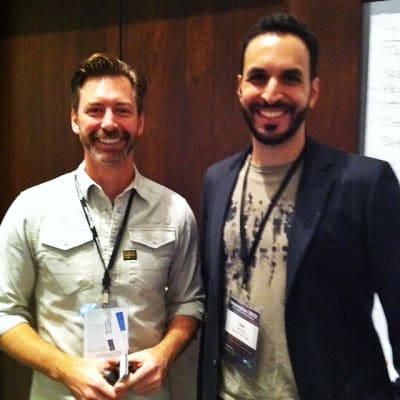Presenters:
 |
| Richard Branfield (@freshtilledsoil) and Joe Baz (@joebaz) |
This
conversation covered a lot of ground around UX (user experience) and UI (user
interface). Ready? Let’s go:
conversation covered a lot of ground around UX (user experience) and UI (user
interface). Ready? Let’s go:
How do you
know what to put into a UX?
know what to put into a UX?
Two
schools of thought:
schools of thought:
1. Data research – personal development & user
testing
testing
2. Steve Jobs – screw the customer; I know what
I want to build
I want to build
The
truth is something in between and varies by project. Apple does do a lot of research and testing.
truth is something in between and varies by project. Apple does do a lot of research and testing.
Research:
Behavioral
research, customer/user interviews: The
goal is to get past the lies people tell. Learn to identify and get past the
red herrings. For
example, one assignment involved a platform that matches people with personal
trainers. The story users told started out as, “I want to get fit, healthy,
etc.” The truth turned out to be, “I’m lonely and need a companion, support, and
encouragement.”
research, customer/user interviews: The
goal is to get past the lies people tell. Learn to identify and get past the
red herrings. For
example, one assignment involved a platform that matches people with personal
trainers. The story users told started out as, “I want to get fit, healthy,
etc.” The truth turned out to be, “I’m lonely and need a companion, support, and
encouragement.”
Use the “5 whys” Approach – Pretend
you’re a five-year-old. When someone answers your question, ask, “Why?” When
they answer that why, ask again, “Why?” Keep going until you get to the truth
(or they punch you out).
you’re a five-year-old. When someone answers your question, ask, “Why?” When
they answer that why, ask again, “Why?” Keep going until you get to the truth
(or they punch you out).
Remember
that people need different experiences based on their needs and mindset. Not everyone
wants one-click. It works for Amazon, but you don’t want it for filing your
taxes.
that people need different experiences based on their needs and mindset. Not everyone
wants one-click. It works for Amazon, but you don’t want it for filing your
taxes.
Research vs. Intuition – either
way, you have to look at facts. The design solution – need to see how things
are performing. Usability testing – see how it’s being used.
way, you have to look at facts. The design solution – need to see how things
are performing. Usability testing – see how it’s being used.
UX Design
Approach –
Approach –
(Research)
Sketching
Prototyping
Storyboarding
User/Persona
Development
Development
Behavior
Studies (BJ FOGG)
Studies (BJ FOGG)
There
is no “best practice” methodology – just get your ideas out of your head so you
can get people talking and dig down to the depth of the real user experience.
is no “best practice” methodology – just get your ideas out of your head so you
can get people talking and dig down to the depth of the real user experience.
Team
Conflict:
Conflict:
Engineers
vs “witch doctor” of UX – how do you keep the peace and get things done?
vs “witch doctor” of UX – how do you keep the peace and get things done?
Look
at the hard data of what the customers want. Make UX a first-class citizen.
(Google and Apple are doing this – raising the bar.) You need to find ways to
negotiate and integrate all the team members. Coach the unfamiliar through the
process and educate them on and benefits, but back up your
“opinions” with data so you don’t get into the “he said/she said” situation.
at the hard data of what the customers want. Make UX a first-class citizen.
(Google and Apple are doing this – raising the bar.) You need to find ways to
negotiate and integrate all the team members. Coach the unfamiliar through the
process and educate them on and benefits, but back up your
“opinions” with data so you don’t get into the “he said/she said” situation.
Meet
as a group, but also meet one-on-one – you can get a lot more information and
also reach solutions more quickly and give everyone a chance to contribute to
the final solution. Ask the questions and drill-down one issue at a time. Then bring everything back to the larger group.
as a group, but also meet one-on-one – you can get a lot more information and
also reach solutions more quickly and give everyone a chance to contribute to
the final solution. Ask the questions and drill-down one issue at a time. Then bring everything back to the larger group.
· -Identify the problem
· -Clearly state the hypothesis
· -Validate the hypothesis
DEFINE:
·
UX – user experience (process or solution) –
strategy (ex: 1-click process)
UX – user experience (process or solution) –
strategy (ex: 1-click process)
·
UI – user interface (navigation, visual
elements) – execution (ex: 1-click button)
UI – user interface (navigation, visual
elements) – execution (ex: 1-click button)
How do you meet customer requirements across
redesign of entire product?
redesign of entire product?
Companies
that are lacking in user experience strategy have to start there – step back and first
say, “What are we trying to do here? What’s the vision for the company?” This requires gathering within the context of the bigger picture – you need to know what the point is.
that are lacking in user experience strategy have to start there – step back and first
say, “What are we trying to do here? What’s the vision for the company?” This requires gathering within the context of the bigger picture – you need to know what the point is.
Depending
on the stage of the idea or feature, you could get feedback from existing
customers OR if at an earlier stage (hardly any customers) – go with the
hypothesis-driven approach. Don’t just blindly follow a competitor. You don’t
know if they are doing it right – it’s better to talk to customers. That’s a culture
you want to encourage and nurture.
on the stage of the idea or feature, you could get feedback from existing
customers OR if at an earlier stage (hardly any customers) – go with the
hypothesis-driven approach. Don’t just blindly follow a competitor. You don’t
know if they are doing it right – it’s better to talk to customers. That’s a culture
you want to encourage and nurture.
Everyone
on your team can contribute to the UX effort.
on your team can contribute to the UX effort.
Cloud &
SaaS – now since they are experiential in nature, does that add more value to UX?
SaaS – now since they are experiential in nature, does that add more value to UX?
In the 90’s you built from the bottom up: exp infrastructure (data base, app, and then UI
design)
design)
NOW experience leads the way. You can build in the cloud where most of the infrastructure exists, and you can focus on the experience and then figure out
what platform you want to put it on. This is an executive function (vs. marketing) –
it’s a “What are we trying to create?” question.
what platform you want to put it on. This is an executive function (vs. marketing) –
it’s a “What are we trying to create?” question.
Mobile: How
do you strike a balance between using current interaction methods and doing
something new?
do you strike a balance between using current interaction methods and doing
something new?
Use MAYA – Most Advanced Yet Acceptable.
People
have certain expectations as a foundation of the experience. You need to find
out what your audience’s basic expectations are and then you can push the
needle just a little bit (UI, new process, etc). Maybe just test with a small
segment of a customer base before a full release.
have certain expectations as a foundation of the experience. You need to find
out what your audience’s basic expectations are and then you can push the
needle just a little bit (UI, new process, etc). Maybe just test with a small
segment of a customer base before a full release.
Just
because it’s new doesn’t mean it’s better. You need to make sure the UX has depth and isn’t just a surface treatment. The
expectation set by the visual layer must be met by the functional experience
that lives beneath that.
because it’s new doesn’t mean it’s better. You need to make sure the UX has depth and isn’t just a surface treatment. The
expectation set by the visual layer must be met by the functional experience
that lives beneath that.
Note: the people who make quantum leaps
based on “instincts” usually have great market knowledge – they’ve put in their
10K hours and their “intuition” is actually based on experience.
based on “instincts” usually have great market knowledge – they’ve put in their
10K hours and their “intuition” is actually based on experience.
Prototype
approach – just build something and get it out so you can collect user data. Use
paper and pen!
approach – just build something and get it out so you can collect user data. Use
paper and pen!
Apps:
Balsalmiq, Mockups, POP App Factory, Omnigraffle, Keynote (with Keynotopia),
Proto.io
Balsalmiq, Mockups, POP App Factory, Omnigraffle, Keynote (with Keynotopia),
Proto.io
Show
the sketches or prototypes to customers. Be the computer, and have customers tap
where they want to go and show them the next screen. You get much better
feedback if you actually show them vs. just describing it. Walk-throughs are
very valuable. Get your proof points.
the sketches or prototypes to customers. Be the computer, and have customers tap
where they want to go and show them the next screen. You get much better
feedback if you actually show them vs. just describing it. Walk-throughs are
very valuable. Get your proof points.
How do you
know when you have to update?
know when you have to update?
Ask
yourself – have you solved the problem? You have an inventory of identified
problems and then monitor whether you’ve solved them. If and when
you get by that stage and you’ve proven your hypotheses, now look at how to optimize (via split testing, etc) based on customer satisfaction, revenue,
profitability, etc.
yourself – have you solved the problem? You have an inventory of identified
problems and then monitor whether you’ve solved them. If and when
you get by that stage and you’ve proven your hypotheses, now look at how to optimize (via split testing, etc) based on customer satisfaction, revenue,
profitability, etc.
Listen
to your customers – always. If you hear the same complaints over and over – you
need to optimize.
to your customers – always. If you hear the same complaints over and over – you
need to optimize.
Use Google
Analytics to see what parts of the app people are using.
Analytics to see what parts of the app people are using.
· Watch behaviors not page views. Take advantage of GA custom variables –
segment the audience. Buyer or admin might have different experience than
lower level users. If bugs go unreported, that’s an indication
that no one is using that feature.
segment the audience. Buyer or admin might have different experience than
lower level users. If bugs go unreported, that’s an indication
that no one is using that feature.
We’re still
designing UX as desktop first and later mobile, tablet, etc. Will we ever get
to a point where all versions of UX are designed simultaneously?
designing UX as desktop first and later mobile, tablet, etc. Will we ever get
to a point where all versions of UX are designed simultaneously?
As
we replace OS software with Web software it will become more consistent. The
experiences and expectations will change with the environment from large screen
to smartphone, etc.
we replace OS software with Web software it will become more consistent. The
experiences and expectations will change with the environment from large screen
to smartphone, etc.
Responsive
design:
Desktops/laptops vs. tablets vs. phones
design:
Desktops/laptops vs. tablets vs. phones
It used
to always start with desktop and then a mobile. Now, within the code, we can create a separate but consistent experience that
accommodates the display screen. The browser triggers which version gets used.
Once code base that accommodates not only re-sizing, but re-flowing
information, only showing certain information, etc.
to always start with desktop and then a mobile. Now, within the code, we can create a separate but consistent experience that
accommodates the display screen. The browser triggers which version gets used.
Once code base that accommodates not only re-sizing, but re-flowing
information, only showing certain information, etc.
Get
out of the mindset of delivering pages, but delivering content “pieces” and web
services – optimize for the user need.
out of the mindset of delivering pages, but delivering content “pieces” and web
services – optimize for the user need.
Sometimes
start with mobile and then scale up – mobile approach is more effective and
efficient. It gets you focused on what you really need vs. “everything but the
kitchen sink.”
start with mobile and then scale up – mobile approach is more effective and
efficient. It gets you focused on what you really need vs. “everything but the
kitchen sink.”
UX/UI
Resources:
Resources:
TEDTalk
– Everything
is Remixed
– Everything
is Remixed
Remember to be
cautious about best practices – focus on your
audience. Differentiate
your UX so that you can stand out in the market.
cautious about best practices – focus on your
audience. Differentiate
your UX so that you can stand out in the market.
Jamie Wallace helps clients create resonant brands,
standout content, and loyalty-inspiring customer experiences at Suddenly Marketing. And, she makes
sure they have fun doing it.
Twitter: @suddenlyjamie
standout content, and loyalty-inspiring customer experiences at Suddenly Marketing. And, she makes
sure they have fun doing it.
Twitter: @suddenlyjamie



